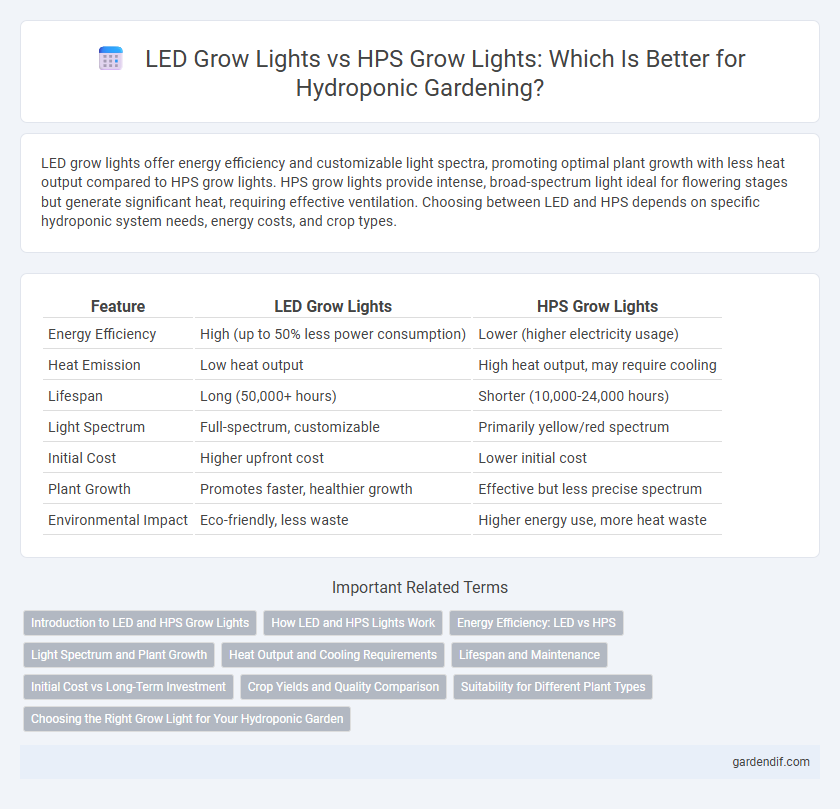
LED Grow Lights vs HPS Grow Lights Illustration
LED grow lights offer energy efficiency and customizable light spectra, promoting optimal plant growth with less heat output compared to HPS grow lights. HPS grow lights provide intense, broad-spectrum light ideal for flowering stages but generate significant heat, requiring effective ventilation. Choosing between LED and HPS depends on specific hydroponic system needs, energy costs, and crop types.
Table of Comparison
| Feature | LED Grow Lights | HPS Grow Lights |
|---|---|---|
| Energy Efficiency | High (up to 50% less power consumption) | Lower (higher electricity usage) |
| Heat Emission | Low heat output | High heat output, may require cooling |
| Lifespan | Long (50,000+ hours) | Shorter (10,000-24,000 hours) |
| Light Spectrum | Full-spectrum, customizable | Primarily yellow/red spectrum |
| Initial Cost | Higher upfront cost | Lower initial cost |
| Plant Growth | Promotes faster, healthier growth | Effective but less precise spectrum |
| Environmental Impact | Eco-friendly, less waste | Higher energy use, more heat waste |
Introduction to LED and HPS Grow Lights
LED grow lights utilize light-emitting diodes to provide a targeted spectrum ideal for plant photosynthesis, offering energy efficiency and low heat output compared to traditional lighting. High-pressure sodium (HPS) grow lights emit a broad spectrum of yellow-orange light, making them effective for flowering stages but with higher energy consumption and heat production. Both types are essential in hydroponic systems, with LEDs favored for precise light management and HPS preferred for intense flowering light intensity.
How LED and HPS Lights Work
LED grow lights use semiconductor diodes that emit specific light spectra ideal for plant photosynthesis, enabling precise control over light intensity and wavelength. HPS (High-Pressure Sodium) grow lights operate by passing electricity through sodium vapor, producing a broad spectrum of intense yellow-orange light that mimics natural sunlight. Both lighting systems support plant growth but differ significantly in energy efficiency, heat output, and spectral customization.
Energy Efficiency: LED vs HPS
LED grow lights offer significantly higher energy efficiency compared to HPS grow lights, consuming up to 40-60% less electricity while providing comparable or superior light intensity for plant growth. The advanced diodes in LEDs convert more electricity into usable light with less heat output, reducing cooling costs and improving overall system sustainability. HPS lights, while effective in spectrum output, typically waste more energy as heat, leading to increased operational costs and less energy-efficient cultivation.
Light Spectrum and Plant Growth
LED grow lights offer a customizable light spectrum that closely mimics natural sunlight, promoting photosynthesis and enhancing plant growth efficiency compared to HPS grow lights. HPS grow lights primarily emit a yellow-orange spectrum with high intensity in the red wavelength, which supports flowering but lacks the balanced spectrum needed for optimal vegetative growth. The ability of LED grow lights to deliver specific wavelengths, including blue and red light, supports both vegetative and flowering stages, resulting in healthier plants and potentially higher yields in hydroponic systems.
Heat Output and Cooling Requirements
LED grow lights produce significantly less heat compared to HPS grow lights, reducing the need for extensive cooling systems in hydroponic setups. The lower heat output from LEDs minimizes the risk of leaf burn and creates a more stable growing environment, enhancing plant health and energy efficiency. In contrast, HPS lights generate substantial heat, necessitating powerful ventilation and cooling solutions to maintain optimal temperature levels in the grow space.
Lifespan and Maintenance
LED grow lights offer a significantly longer lifespan, typically lasting between 50,000 to 100,000 hours, compared to High-Pressure Sodium (HPS) lights, which average around 24,000 hours. Maintenance requirements for LED lights are minimal, as they generate less heat and have durable components that reduce the need for frequent replacements or cooling systems. HPS grow lights demand regular bulb replacements and maintenance of ballast units to ensure optimal performance and prevent overheating.
Initial Cost vs Long-Term Investment
LED grow lights have a higher initial cost compared to HPS grow lights but offer significant energy savings and longer lifespan, reducing overall expenses in the long term. HPS grow lights require frequent bulb replacements and consume more electricity, leading to increased operational costs over time. Investing in LED technology maximizes return through improved efficiency and lower maintenance, making it a cost-effective solution for sustained hydroponic cultivation.
Crop Yields and Quality Comparison
LED grow lights provide higher crop yields with improved energy efficiency and customizable light spectra that promote optimal plant growth and nutrient density compared to HPS grow lights. HPS grow lights emit more heat, potentially stressing plants and reducing quality, while LEDs enhance cannabinoid and terpene production in hydroponic systems. Studies show LED systems can increase yields by up to 25% and improve crop quality metrics, including flavor and potency, making them the preferred choice for hydroponic cultivation.
Suitability for Different Plant Types
LED grow lights offer customizable light spectra ideal for leafy greens, herbs, and seedlings, enhancing photosynthesis and growth efficiency. HPS grow lights emit a broad spectrum with strong red and orange wavelengths, making them suitable for flowering and fruiting plants such as tomatoes and peppers. Choosing between LED and HPS depends on the plant's growth stage and specific light spectrum requirements for optimal development.
Choosing the Right Grow Light for Your Hydroponic Garden
LED grow lights offer energy efficiency, longer lifespan, and customizable light spectrums specifically tailored for hydroponic gardens, enhancing plant growth and yield. HPS grow lights provide intense, broad-spectrum light ideal for flowering stages but consume more energy and generate significant heat. Selecting the right grow light depends on balancing energy costs, heat management, and growth phase requirements to optimize hydroponic plant health and productivity.
LED Grow Lights vs HPS Grow Lights Infographic

 gardendif.com
gardendif.com